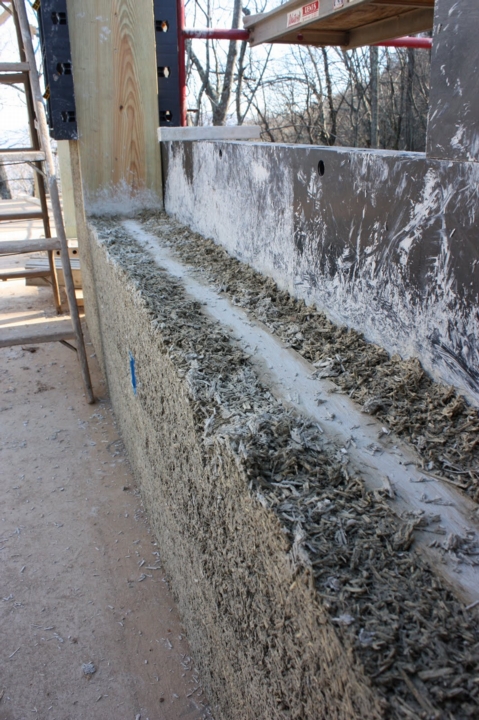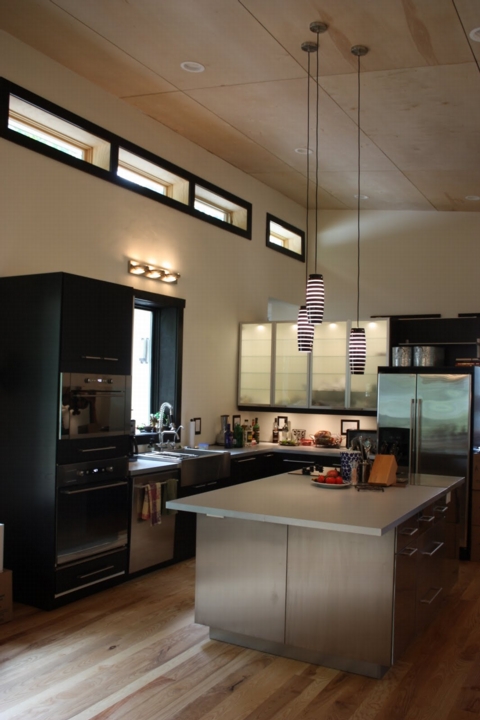This is a great article and full of amazing information. Concrete from Hemp. Super!
Blog Post
Hemcrete – A Hemp-Lime Composite Insulation for Walls

Tradical® Hemcrete® is a non-structural, rigid, insulating, composite wall fill comprised (by weight) of about 38% hemp and 62% lime-based binder. The Tradical lime binder is manufactured in the U.K. by Lime Technology, Ltd., under license from multinational Lhoist Group, headquartered in Belgium with lime operations worldwide.
I first learned about Hemcrete at the Build Well Symposium in San Francisco last January. Mario Machnicki of American Lime Technologyin Chicago, the U.S. distributor of the Tradical Hemcrete wall system. To date, four to five houses have been built in the U.S. using Hemcrete, including a just-completed house in Asheville, North Carolina, that has been widely publicized.

The industrial hemp used in Hemcrete (the same species as marijuana, but with far less of the narcotic THC) is currently sourced from England, where it can be grown legally, but Tom Glab of American Lime Technology told me that they are working to find a source in Canada, where industrial hemp is also legal.
Federal law in the U.S. currently prohibits the cultivation of industrial hemp--though in the past it was widely grown for many uses, including paper, rope, and textiles. In fact, hemp sails carried Columbus's ships to the New World, founding fathers George Washington and Thomas Jefferson grew hemp, and until the late 1800s three-quarters of the world's paper was made from hemp, as were most fabrics until the 1820s with the invention of the cotton gin.

Hemp proponents point out that the plant can be grown with very low environmental impacts--little fertilizer or pesticides being needed--and that a building system based on hemp sequesters carbon very effectively. One acre of help produces 4.1 times as much fiber as the same acre of trees, according to Hemp Technologies, LLC, and the plant removes carbon from the atmosphere four times as efficiently as trees.
To make Hemcrete, the dried stems of hemp, referred to as "shiv," are mixed with the lime-based binder. Moistened, the mix is placed into wall forms--typically spaced to achieve a 12-inch-thick wall--which can be removed the next day. While the material hardens to a rigid, concrete-like form (I have a large sample from American Lime Technology sitting on my desk, and it seems very strong), it is considered non-structural. Wood or steel framing members are used in the wall system to provide structural support.
SUPPORT INDEPENDENT SUSTAINABILITY REPORTING
BuildingGreen relies on our premium members, not on advertisers. Help make our work possible.
See membership options »
After removing the forms, two layers of lime stucco are applied on the exterior, a base coat and a finish coat. The interior side is finished with lime plaster. With the lime stucco and plaster, the entire wall system is breathable.
In the U.K., Hemcrete is also sprayed into an open cavity, using Gunite or shotcrete technology, against a single form that remains in place, but to-date, only poured applications have been done in North America.
As for thermal performance, Hemcrete insulates to about R-2.3 per inch, according to Tom Glab, so a typical 12-inch-thick wall provides about R-28. This is a reasonable R-value in moderate climates where use of the material is being most actively pursued. The monolithic wall system also provides effective thermal mass--like adobe or autoclaved aerated concrete--which can be beneficial in climates with a lot of sun and large diurnal temperature swings (such as the Mountain states and Southwest).
Cost depends on the purchase volume--due (today) to the costs of shipping from the U.K. When ordered by the 40-foot container load, a 22 kg (49 lb) bag of binder costs about $30 and a 20 kg (44 lb) bag (bale) of hemp shiv costs $28. Including the base and finish stuccos, Glab said the materials cost for a 12-inch wall are about $19/sq ft. American Lime Technology is hoping to source the materials closer to home: "The idea is to be green, so we want to avoid transportation from England," Glab told me.
One of the first completed houses in the U.S. using Hemcrete was designed and built by Anthony Brenner of Push Design, in Asheville, North Carolina. The 3,400 sq ft home is owned by a past mayor of Asheville, Russ Martin, and his wife. Completed this summer, the "Push House" features a wide range of green features besides the Hemcrete walls. Total construction cost of the house, according to a recent CNN news report was $133 per sq ft.
For more information:
American Lime Technology
Chicago, Illinois
773-286-0566
Alex Wilson is the executive editor of Environmental Building News and founder of BuildingGreen, LLC. In addition to this product-of-the week blog, he writes the weekly Energy Solutions blog. To keep up with his latest articles and musings, you can sign up for his Twitter feeds.
See more on this product in the GreenSpec Guide
Published September 11, 2010 Permalink Citation
(2010, September 11). Hemcrete – A Hemp-Lime Composite Insulation for Walls. Retrieved from https://www.buildinggreen.com/news-article/hemcrete-–-hemp-lime-composite-insulation-walls
Comments
I am using paper base blown i
I am using paper base blown in insulation to make papercrete. I think this would work well for making papercrete!





Add new comment
To post a comment, you need to register for a BuildingGreen Basic membership (free) or login to your existing profile.